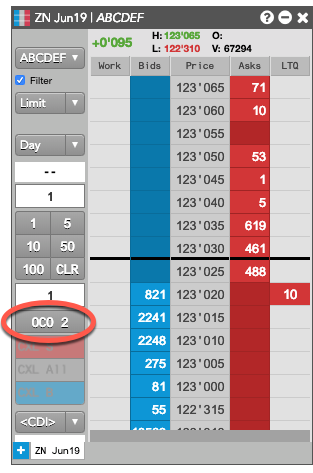Order Management Algos (OMAs)
Launching the OCO 2 and Conditional OMAs
The Conditional and OCO 2 TT public algos support an "order building" mode that lets you dynamically build an OMA from existing or new orders in MD Trader. When order building mode is activated, the selected button and all MD Trader header panels are shaded yellow to indicate that building mode is active. You can then add or create orders to be managed by the OMA. New orders are added to MD Trader in a held state so they don't start working until the OMA is launched.

Also, custom action buttons that support order building mode can be added to any visible MD Trader widget. You do not need to add one to other MD Trader widgets whose orders you want to use in the OMA.
Prerequisites
Before launching the OCO 2 and Conditional public algos from MD Trader, you must:
- Create templates for the algos using Template Manager or Algo Dashboard.
- Add custom action buttons for one of the templates to an MD Trader widget.
Adding OMA buttons to MD Trader for Conditional and OCO 2 algos
To launch the Conditional and OCO 2 TT public algos from an MD Trader widget, you add a custom action button for the algo. The custom action button must be associated with a specific template for an OMA; you cannot use the default template for OMA algos you want to use in order building mode.
To add a custom action button for order building mode:
- From an MD Trader Order Entry panel context menu, select Edit custom action buttons. Note: You can add the button to any MD Trader widget.
- Select the OMA algo, then select a template. You can also customize the button text, if desired. Note: Templates can be created in Algo Dashboard.
-
Click OK to add the button to the current MD Trader widget.

For more information about adding custom action buttons to MD Trader, see Adding custom action buttons.
Launching OMAs in builder mode
To launch TT public OMAs in builder mode:
-
In MD Trader, click the custom action button you added for the OMA.
The background color of the button and all MD Trader Header panels changes to yellow to indicate your are now in order builder mode, and the OMA order builder opens for the associated OMA algo.

-
Either use shift-right-click to select an existing order or enter a new order in an MD Trader widget.
The selected or new order is added to order builder.

- Shift-right-click the working order to add it to the algo order.
- The selected order appears in the order builder.
-
Either use shift-right-click to select an existing order or enter a new order in an MD Trader widget.

-
In the order builder, click Launch algo.
You can also enable Auto-launch to launch the algo automatically when the algo's required number of orders is added. The new algo parent order, along with its child orders, are added to the Order Book.
Note: When launching a TT Conditional OMA, the Primary (first) order is submitted as a Working order, while the Conditional (second) child order is submitted as a Held order. When the primary order receives a fill, the conditional order changes to Working status.

Canceling Conditional or OCO 2 OMA orders
If you cancel the parent order of a Conditional or OCO 2 algo, the parent order is deleted and:
- Child orders added from existing orders will remain working in market.
- Child orders added as new orders will be deleted.
OCO OMA parameters
Note: If you launch these algos from MD Trader, you customize these parameters when creating their correspoding templates. Otherwise, you can define them when selecting an algo in Order Book.
The OCO 2 and Conditional OMAs use the following parameters:
-
Delete orphan: Whether to delete the balance of a larger order when an order with a smaller quantity is fully-filled.
If, at any time, the working quantity of any one of the OCO OMA child orders goes to zero, the other orders are considered to be "orphans." When this parameter is TRUE, all remaining orders are deleted, regardless of their working quantities. -
Enforce Mkt State: Whether to delete the OCO order, and its child orders, if the market state of one of the child instruments changes to a non-tradable state.
If the market state of an instrument changes to something other than Open, and Enforce Mkt State is enabled, all orders will be deleted. -
Proportional: Method to use when reducing the quantities of other legs when one leg is filled.
- True: Reduce the other leg quantities by the same proportion of the fill quantity to the order quantity of the filled order.
- False: (Default) Reduce the other leg quantities by the fill quantity of the filled order.
- Ignore Market State: Whether to ignore the market state when submitting the parent OCO OMA.
- Instance name: Optional name for this algo instance.
-
Co-location: Location of the Algo Server to run this algo.
The Co-location drop down is seeded based on the market of the default instrument in the selected algo. It will also seed when multiple instruments are defined if all instruments are from the same market. -
Disconnect action: Action to take if the client loses its connection to TT:
- Leave to allow the algo to continue running normally.
- Pause to suspend the algo until you manually restart it.
- Cancel to delete the algo.